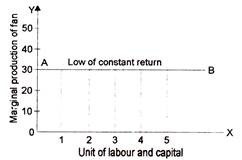The below mentioned article provides a study note on the law of constant returns.
The Law of Constant Returns is said to operate when the additional investment of labour and capital yields the same return as before.
It means the return from investment remains the same as the business is expanded or contracted.
In other-words, it can be said that “whatever the scale of production, the cost of the product per unit remains the same.”
ADVERTISEMENTS:
According to Stigler – “When all the productive services are increased in a given proportion, the product is increased in the same proportion.”
Law of Constant Return remains active for some-time. From where the activeness of Law of Increasing Return ends, from there the Law of Constant Return starts and after the end of the activeness of this Law of Diminishing Return starts operation.
In other-words, it can be said that when the business moves towards the optimum, the returns increase and when it goes beyond the optimum the returns decrease. But if after having reached the optimum point, the industry is stabilized at the level of output, the returns continue to be the same; and they are said to be constant.
This law can be illustrated by the following example:
From this table it is clear that by increase in the unit of labour and capital, total production increases but the marginal production remains constant i.e., 30 is the constant figure; and this figure is Law of Constant Return.
Diagrammatic Representation:
This Law of Constant Returns can be represented in a diagram as follows:
On OX axis unit of labour and capital and on OY axis marginal production of fan has been shown. AB line is the Law of Constant Return because it shows that in-spite of increase in the unit of labour and capital marginal production of fan is the same. In other-words, here AB line is the Law of Constant Return.
ADVERTISEMENTS:
Why Law of Constant Returns?
In every industry, we find the influence of man and nature. Nature controls the supply of raw-materials while man directs the manufacturing side. If there is an industry where the cost of raw-materials and the manufacturing costs are half and half, we can say that both man and nature influence equally. Such an industry would be subject to the Law of Constant Returns. For example – The woolen blanket weaving industry. Here the cost of wool is supposed to cost as much as the other manufacturing costs put in the manufacturing.
Further, if there is an integration of the extractive and manufacturing industries like sugar-making and cane-growing, steel making and iron-ore mining the Law of Constant Returns may operate. Here, the two aspects of the industry are combined, viz., the agricultural aspect which is subject to the law of diminishing returns and the manufacturing aspect which is subject to the Law of Increasing Returns.
It is possible for these two tendencies to counterbalance each other with the result that the Law of Constant Returns may operate. Thus, we find that in every industry there are two tendencies and constantly at work viz., one of diminishing returns and the other of increasing returns. Whenever this scale of production is increased the cost of raw materials and other factors may go up on account of increased demand.
This tends to raise the cost of production per unit or to bring about the operation of the Law of Diminishing Returns. But the larger the scale the greater the economies in the use of machinery, division of labour, buying and selling, research and publicity etc.
In actual life, however, either the tendency of diminishing returns is stronger or the increasing returns tendency is stronger. Thus, the operation of the Law of Constant Returns is rather rare and if at all it operates, it lasts only for a short period of time.
There are mainly two factors which give rise to the Law of Increasing Returns to scale:
1. Indivisibilities of the factors of production.
ADVERTISEMENTS:
2. Specialisation of factors of production.

